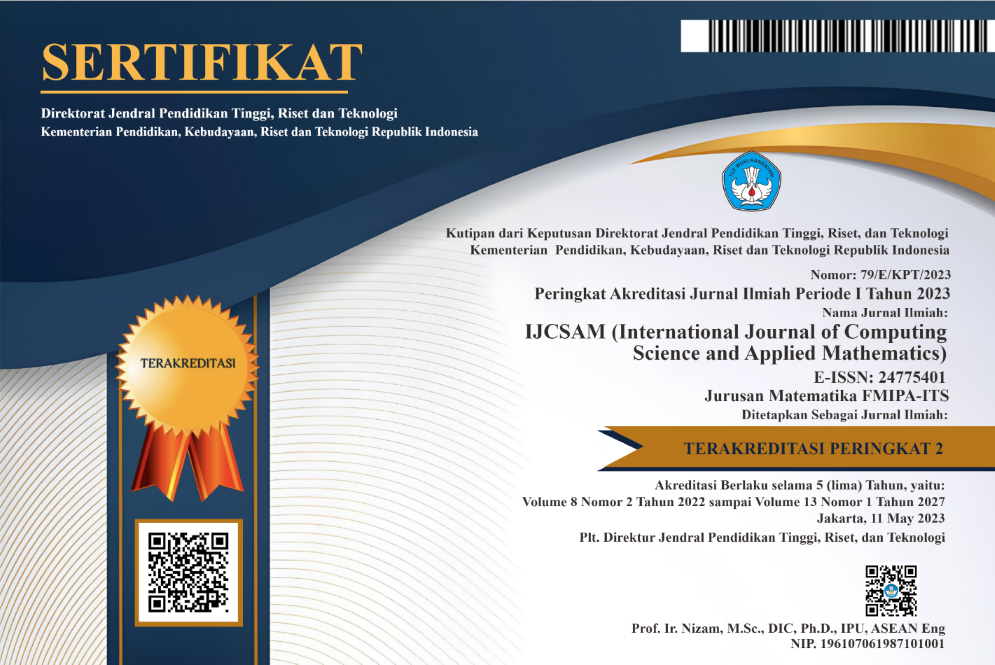Optimization of Tire Production Planning Using The Goal Programming Method and Sensitivity Analysis
Abstract
Keywords
Full Text:
PDFReferences
A. Chirzun, N. Nurhasanah, and T. A. Utami, “Rancangan perencanaan produksi jenis produk make to order dengan pendekatan simulasi sistem dinamik,” Jurnal Al-Azhar Indonesia Seri Sains dan Teknologi, vol. 3, no. 3, pp. 113–119, 2017.
M. B. Soeltanong and C. Sasongko, “Perencanaan produksi dan pengendalian persediaan pada perusahaan manufaktur,” Jurnal Riset Akuntansi & Perpajakan (JRAP), vol. 8, no. 01, pp. 14–27, 2021.
P. C. Paath, J. Tjakra, and A. Dundu, “Analisis pengendalian bahan proyek pembangunan dengan metode goal programming prioritas (studi kasus: Proyek pembangunan gedung sekolah eben haezar),” Jurnal Sipil Statik, vol. 3, no. 5, 2015.
M. Y. Kabosu and K. Kartiko, “Analisis goal programming (gp) pada optimalisasi perencanaan produksi mebel ud. latanza,” Jurnal Statistika Industri dan Komputasi, vol. 5, no. 01, pp. 22–40, 2020.
I. Nuryana, “Optimasi jumlah produksi pada umkm raina kersen dengan metode linear programming,” 2019.
D. M. N. Faisal, H. Bagus, and S. Sunarya, “Perhitungaan metode goal programming untuk optimasi perencanaan produk keripik singkong pada pt. cassava chips,” Bulletin of Applied Industrial Engineering Theory, vol. 2, no. 1, 2021.
D. R. Indah and P. Sari, “Penerapan model linear programming untuk mengoptimalkan jumlah produksi dalam memperoleh keuntungan maksimal (studi kasus pada usaha angga perabot),” Jurnal Manajemen Inovasi, vol. 10, no. 2, 2020.
Y. R. Akbar et al., “Optimasi produksi pada industri kecil dan menengah karya unisi dengan penerapan model linear programming,” Jurnal Inovasi Penelitian, vol. 2, no. 8, pp. 2883–2892, 2022.
S. Suryanto, E. S. Nugroho, and R. A. K. Putra, “Analisis optimasi keuntungan dalam produksi keripik daun singkong dengan linier programming melalui metode simpleks,” Jurnal Manajemen, vol. 11, no. 2, pp. 226–236, 2019.
A. Akram, A. Sahari, and A. I. Jaya, “Optimalisasi produksi roti dengan menggunakan metode branch and bound (studi kasus pada pabrik roti syariah bakery, jl. maleo, lrg. viii no. 68 palu),” Jurnal Ilmiah Matematika dan Terapan, vol. 13, no. 2, 2016.
M. Martini et al., “Optimasi produksi hijab dengan fuzzy linear programming,” JITK (Jurnal Ilmu Pengetahuan dan Teknologi Komputer), vol. 3, no. 1, pp. 65–72, 2017.
P. N. P. Krisnadewi and P. Y. Setiawan, “Optimalisasi produksi pada usaha kecil kripik terry di desa nyanglan kaja, kecamatan tembuku kabupaten bangli,” E-Jurnal Manaj. Unud, vol. 7, no. 11, pp. 6011–6040, 2018.
R. Rachman, “Optimalisasi produksi di industri garment dengan menggunakan metode simpleks,” Jurnal Informatika, vol. 4, no. 1, 2017.
W. Anggraeni, R. A. Vinarti, R. Tyasnurita, and J. Permatasari, “Production planning optimization using goal programming method in habibah busana,” Journal of Advanced Management Science Vol, vol. 3, no. 4, 2015.
E. E. Ajayi-Daniels, “Resource optimization in a fashion firm: a goal programming approach,” International Journal of management and fuzzy systems, vol. 5, no. 1, pp. 14–20, 2019.
F. Fauziyah, “Penerapan metode goal programming untuk mengoptimalkan beberapa tujuan pada perusahaan dengan kendala jam kerja, permintaan dan bahan baku,” Jurnal Matematika MANTIK, vol. 2, no. 1, pp. 52–59, 2016.
Y. Titilias, L. Linawati, and H. Parhusip, “Optimasi perencanaan produksi kayu lapis pt. xxx menggunakan metode goal programming,” Indonesian Journal of Mathematics and Natural Sciences, vol. 41, no. 1, pp. 13–19, 2018.
W. Widyaningsih and S. Andayani, “Optimasi perencanaan produksi bahan bakar minyak dengan fungsi kendala fuzzy menggunakan metode goal programming,” Pythagoras, vol. 13, no. 1, 2018.
DOI: http://dx.doi.org/10.12962%2Fj24775401.v8i2.7364
Refbacks
- There are currently no refbacks.
View My Stats

International Journal of Computing Science and Applied Mathematics by Pusat Publikasi Ilmiah LPPM, Institut Teknologi Sepuluh Nopember is licensed under a Creative Commons Attribution-ShareAlike 4.0 International License.
Based on a work at https://iptek.its.ac.id/index.php/ijcsam.






